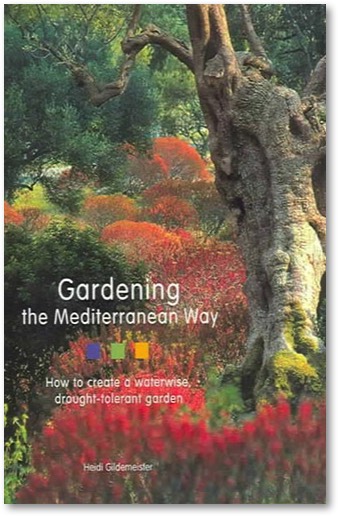
Musings » Gardening the Mediterranean Way: how to create a waterwise, drought-tolerant garden


London
Harry N. Abrams, Inc. 2004
Heidi Gildemeister is a founding member and former president of the Mediterranean Garden Society. This book is a sequel to her first one, Mediterranean Gardening: a Waterwise Approach. To show how serious she is about her subject she lives and gardens in Mallorca, a large island in the Mediterranean Sea. From time to time she comes up for air and travels to places like the Bay area.
Our own Richard G. Turner, editor of Pacific Horticulture, has written a foreword to this book, indicating how difficult it is to find hands-on direction in creating a Mediterranean garden. He has led the way with several impressive symposia at which Heidi Gildemeister was a key speaker.
The climate named for the Mediterranean basin but which is found in four other places, Chile, Cape of Good Hope, California and Southern Australia, consists in mild, wet winters with up to forty inches of rainfall each year and hot dry summers when rain is extremely rare.
The features which distinguish this climate include latitude between 30 and 40 degrees, both north and south of the Equator, and location on the west and south western coasts of continents, where the ocean currents offshore are usually quite cold. Archeology tells us that these regions did not always have this type of climate.
Fossil specimens show that vascular plants which we know nowadays need rainfall evenly dispersed throughout the whole year once flourished in those regions. The olive trees, quintessentially Mediterranean, is a living fossil. While it can survive miserably with no water at all, the tree must be given a little water throughout the summer in order to have a useful crop. Experts interpret this finding to mean that the olive tree dates from that earlier epoch.
Heidi Gildemeister supplies information about how to create your own Mediterranean garden, as well as ideas about siting the property and how to create an atmosphere in the garden. The largest part of her book is headed “Mediterranean Dream Gardens: choosing your own personal Eden”. One might liken this to a series of twenty templates, each one with its own theme. The individual sections are succeeded by excellent lists of the plants which contribute to that ambience.
There is an “Evergreen Eden” in which shrubs and trees are prominent. A “Coastal Haven” deals with the boundary between sea and land. Terracing is the theme of “A Garden in the Hills”. The “Swimming Pool Garden” is self-evident, as is the “Edible Garden”. This is very good way of organizing a huge topic which could easily degenerate into lists and lists with more lists on top of those.
The author comments that for now almost all the plants in these categories tend to be from the Old World. She is not aware for example of a Chilean or Australian garden solely populated with Chilean or Australian plants of the Mediterranean type. That will come one day. Meanwhile here in California we can learn from her wisdom.

